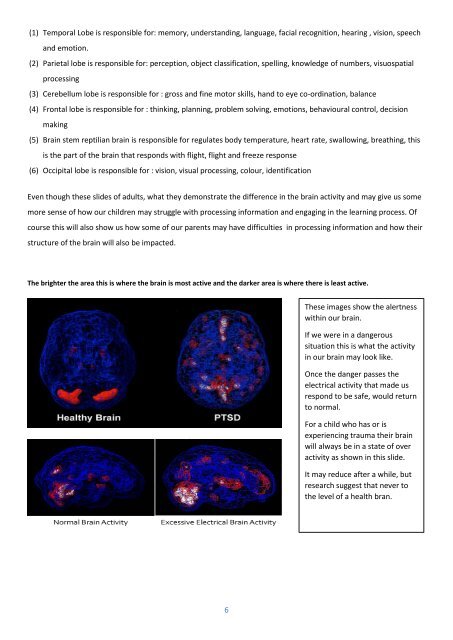Facilitator Notes Understanding Trauma in Classroom Teacher Primary Version final June
You also want an ePaper? Increase the reach of your titles
YUMPU automatically turns print PDFs into web optimized ePapers that Google loves.
(1) Temporal Lobe is responsible for: memory, understand<strong>in</strong>g, language, facial recognition, hear<strong>in</strong>g , vision, speech<br />
and emotion.<br />
(2) Parietal lobe is responsible for: perception, object classification, spell<strong>in</strong>g, knowledge of numbers, visuospatial<br />
process<strong>in</strong>g<br />
(3) Cerebellum lobe is responsible for : gross and f<strong>in</strong>e motor skills, hand to eye co-ord<strong>in</strong>ation, balance<br />
(4) Frontal lobe is responsible for : th<strong>in</strong>k<strong>in</strong>g, plann<strong>in</strong>g, problem solv<strong>in</strong>g, emotions, behavioural control, decision<br />
mak<strong>in</strong>g<br />
(5) Bra<strong>in</strong> stem reptilian bra<strong>in</strong> is responsible for regulates body temperature, heart rate, swallow<strong>in</strong>g, breath<strong>in</strong>g, this<br />
is the part of the bra<strong>in</strong> that responds with flight, flight and freeze response<br />
(6) Occipital lobe is responsible for : vision, visual process<strong>in</strong>g, colour, identification<br />
Even though these slides of adults, what they demonstrate the difference <strong>in</strong> the bra<strong>in</strong> activity and may give us some<br />
more sense of how our children may struggle with process<strong>in</strong>g <strong>in</strong>formation and engag<strong>in</strong>g <strong>in</strong> the learn<strong>in</strong>g process. Of<br />
course this will also show us how some of our parents may have difficulties <strong>in</strong> process<strong>in</strong>g <strong>in</strong>formation and how their<br />
structure of the bra<strong>in</strong> will also be impacted.<br />
The brighter the area this is where the bra<strong>in</strong> is most active and the darker area is where there is least active.<br />
These images show the alertness<br />
with<strong>in</strong> our bra<strong>in</strong>.<br />
If we were <strong>in</strong> a dangerous<br />
situation this is what the activity<br />
<strong>in</strong> our bra<strong>in</strong> may look like.<br />
Once the danger passes the<br />
electrical activity that made us<br />
respond to be safe, would return<br />
to normal.<br />
For a child who has or is<br />
experienc<strong>in</strong>g trauma their bra<strong>in</strong><br />
will always be <strong>in</strong> a state of over<br />
activity as shown <strong>in</strong> this slide.<br />
It may reduce after a while, but<br />
research suggest that never to<br />
the level of a health bran.<br />
6



